Do you ever fancy owning a vintage figurine, but the price tag discourages you? You’re not alone because people in the 20th and 19th centuries felt the same way. The demand for affordable porcelain and ceramic figurines led to Made in Occupied Japan.
“Made in Occupied Japan” and “Made in Japan” may seem interchangeable to an amateur collector, but OGs know they’re not the same. The post-WWII era figurines were Japanese copies and reproductions of established Western models retailing less than $100.
So how much can your grandma’s vintage Made in Occupied Japan figurine fetch you? Is it worth keeping, or should you sell it and make a fortune? Keep reading to find out, but first, here’s a list of the top ten most valuable Made in Occupied Japan figurines today.
Table of Contents
10 Most Valuable Made in Occupied Japan Figurines Online
NB: These prices aren’t fixed, as you’ll learn in the valuation section. They’re, however, the best compiled from reputable online stores like Etsy and eBay.
No. |
Name |
Year |
Price |
1 |
Porcelain Moriyama (Dancing Woman) |
c. 1930s |
$150 |
2 |
Porcelain Frogs |
c. 1940 |
$132 |
3 |
Colonial Man and Woman |
c. 1940 |
$125.49 |
4 |
Twin Cats |
c. 1945 – 1952 |
$106.51 |
5 |
Porcelain Girls Holding Pots in Hand Figurines |
c. 1940s |
$99.83 |
6 |
Horse Drawn Cinderella Carriage |
c. 1940s |
$85 |
7 |
American Lady |
c. 1945 – 1951 |
$70 |
8 |
Yamabushi Tengu Kutani Ware Tokkuri Sake Bottle Yōkai Figure |
c. 1945 |
$62.14 |
9 |
Romantic English Couple |
1950 |
$42 |
10 |
Japanese Man and Woman |
1945 |
$32 |
10. Japanese Man and Woman
Price: $32
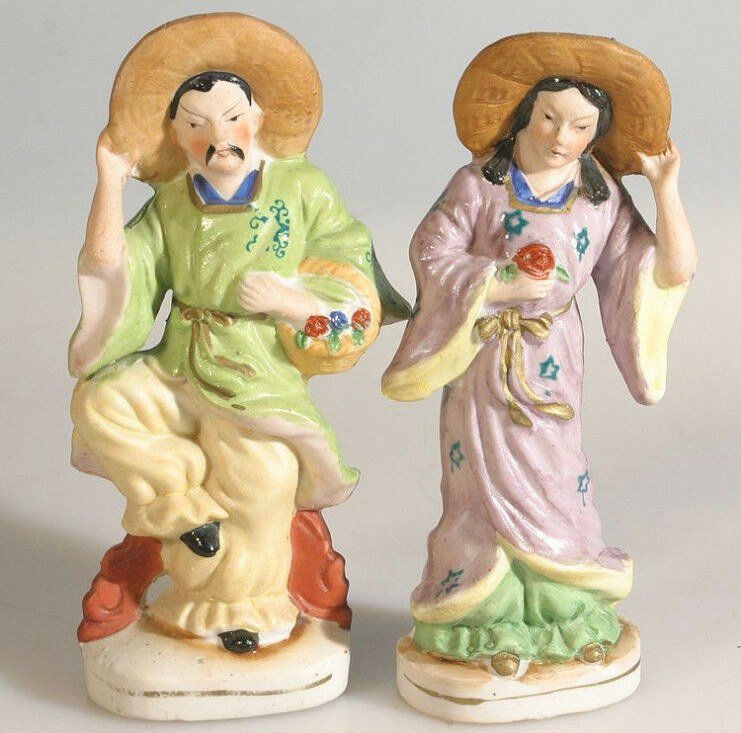
This couple set features two lovers – a man and a woman – going about their daily activities. The man wears a green kimono with blue details, pastel yellow pants, and a triangular hat.
He sits with his right leg crossed over the left while holding a basket in his left hand and his hat with his right.
The black-haired woman wears a pink floral kimono with a green underskirt, and she clutches a flower from the man’s basket to her chest.
9. Romantic English Couple
Price: $42
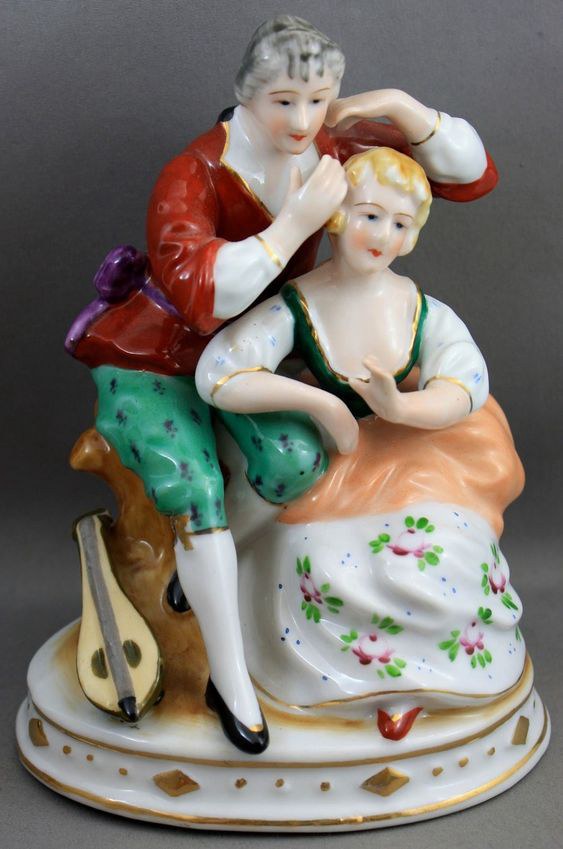
This figurine depicts a couple in a romantic cuddle. The lady sits lower on a tree stump in a green, white, and black pastoral dress while the man gestures to hold her from a higher sitting position. He wears a blue jacket with a red belt tied in a bow, white vest, and stocking.
The man has a banjo at his feet, and the figurine is 7-inches tall.
8. Yamabushi Tengu Kutani Ware Tokkuri Sake Bottle Yōkai Figure
Price: $62.14
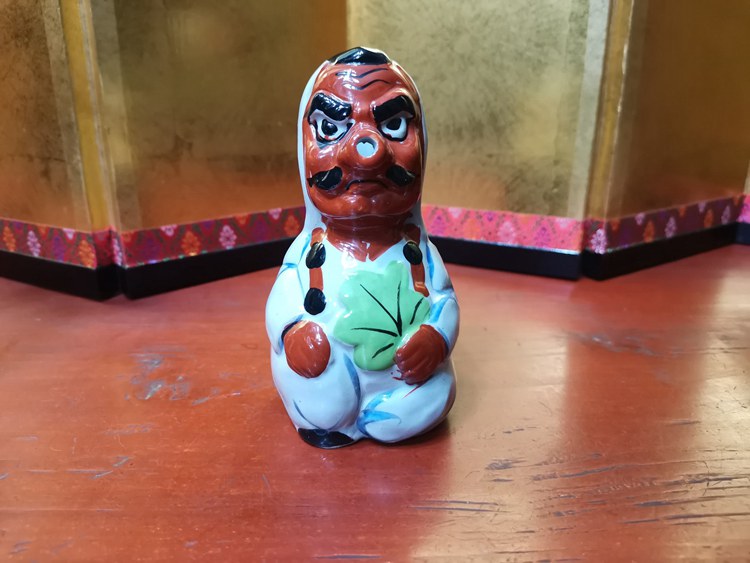
This rare Sake bottle takes the form of a Western Yōkai – the long-nosed mountain goblin, Yamabushi Tengu. According to myth, the character disguises as a poor older man walking barefooted with his leaf-like fan.
If you’re a fan of Japanese mythology, this figurine would be a great addition to your collection.
7. American Lady
Price: $70
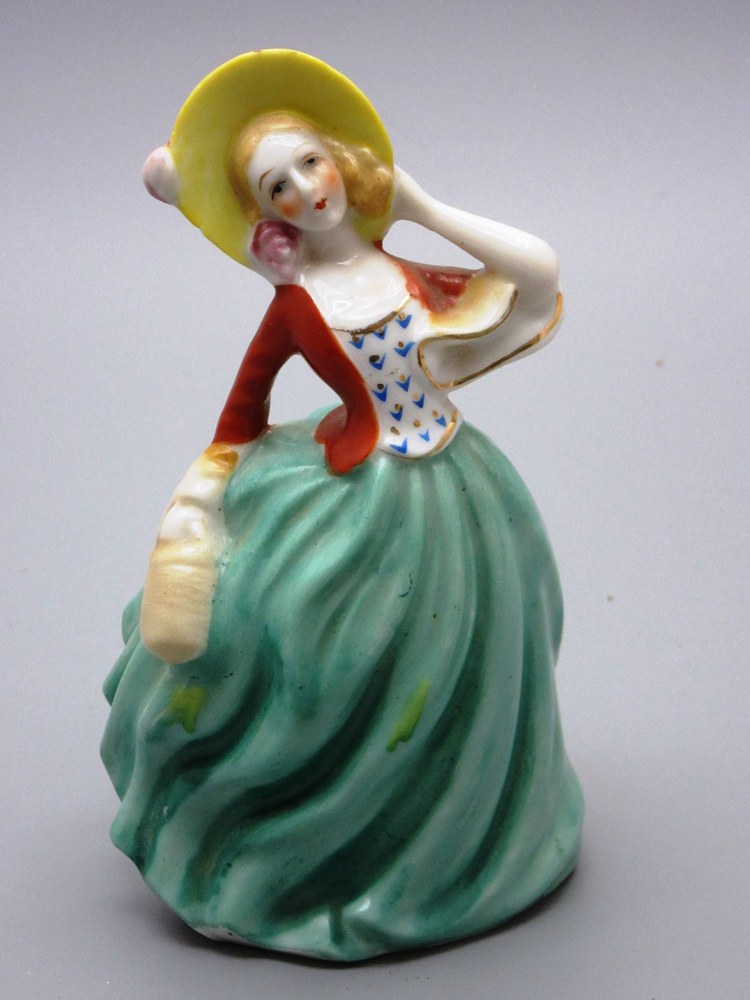
This porcelain figurine is an extremely rare design of a Fancy American lady. Her dress is very colorful with a flowing green skirt and red, white, and blue bodice covering her red hair with a wide-brimmed yellow hat.
She’s a hand-painted 15.5cm tall fancy lady – the perfect décor for your mantel. You can additionally watch this analysis of the risqué American Lady figurine.
6. Horse Drawn Cinderella Carriage
Price: $85
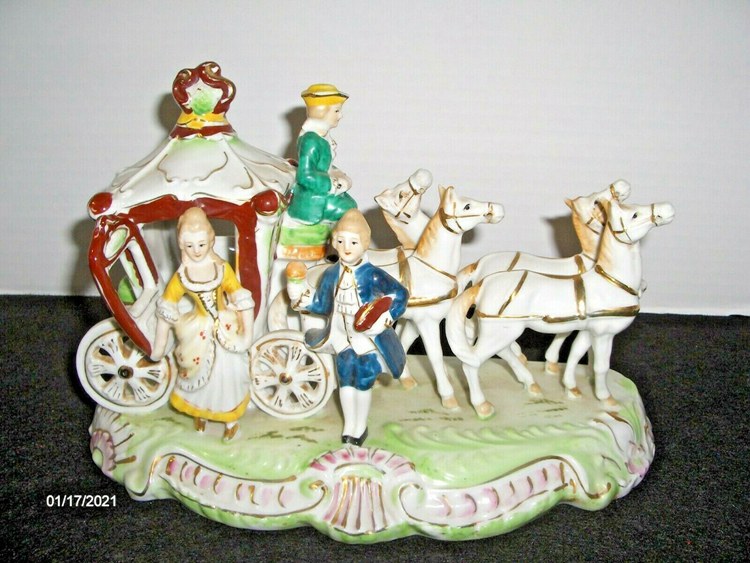
This multi-character figurine is fascinating because it tells a story of a lovely couple alighting from a double-horse-drawn carriage with the foreman still atop. It stands at 5½-inches on a 7¼ x 3¼ -inch base.
It’s also guaranteed authentic hence the high value for a Made in Occupied Japan item.
5. Porcelain Girls Holding Pots in Hand Figurines
Price: $99.83
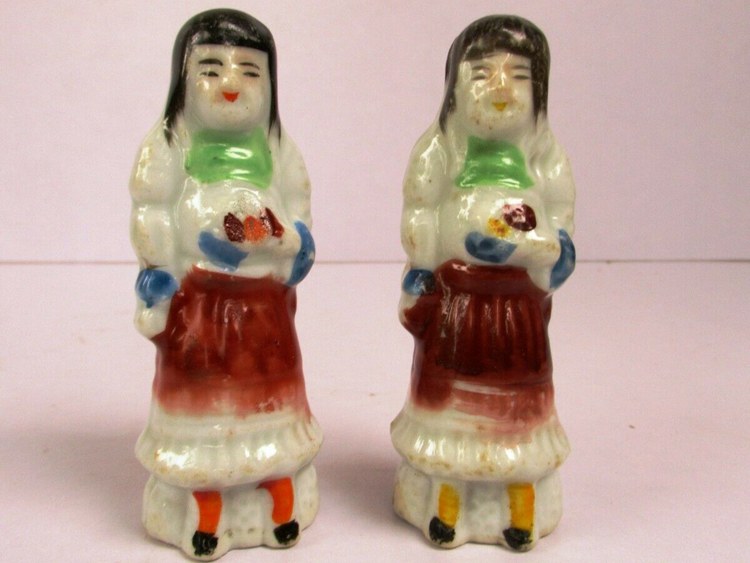
The twin girls are holding identical pots and wearing similar red, white and blue colored dresses. There are slight differences though, one girl has red lips and socks, while the other’s is yellow. They’re 1 x 1 inch wide and 3.8 inches tall with no additional base.
4. Twin Cats
Price: $106.51
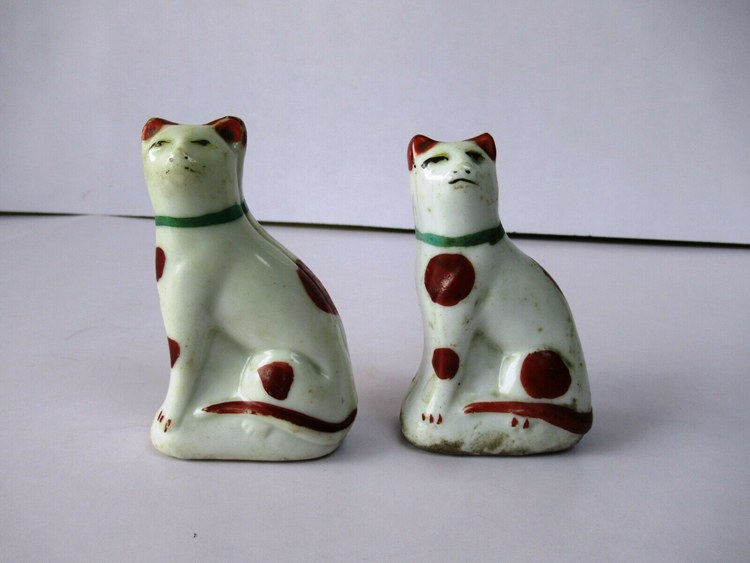
The twin cats come in different color combinations, but off-white/white is often the background. This particular set has green collars and red marks (ears, tails, and spots) on its body. Their facial expression is morose with downward-facing mouths.
3. Colonial Man and Woman
Price: $125.49
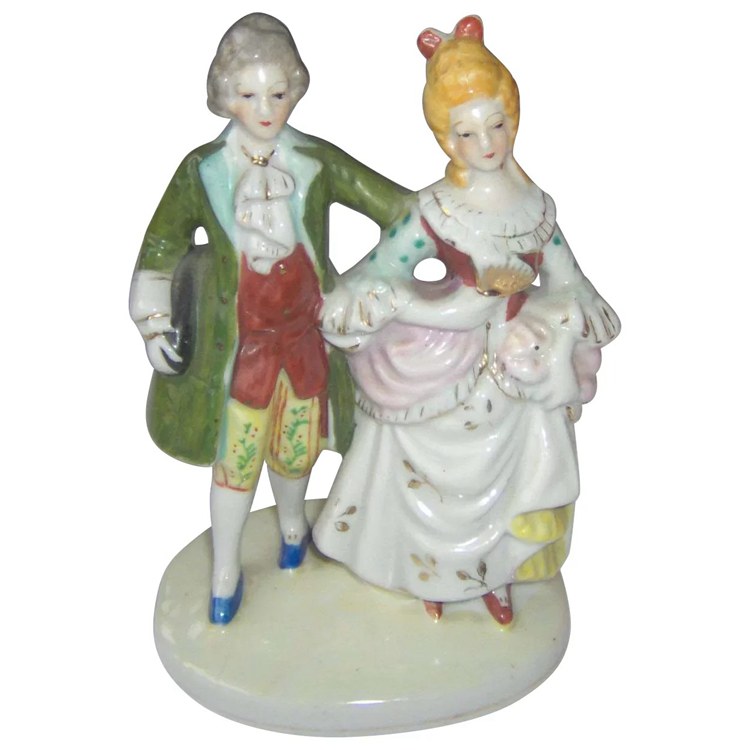
This rare Fine China figurine is a Victorian-era couple. The lady wears a red and green bodice over a pastel blue skirt as she fans herself while the man dons a red, yellow, and black jacket, white and gold embroidered design vest, green pants, and white stockings.
The couple also wore fancy hats, as was common during the Victorian age. They stand at 8-inches, on a 2½-inches base.
2. Porcelain Frogs
Price: $132
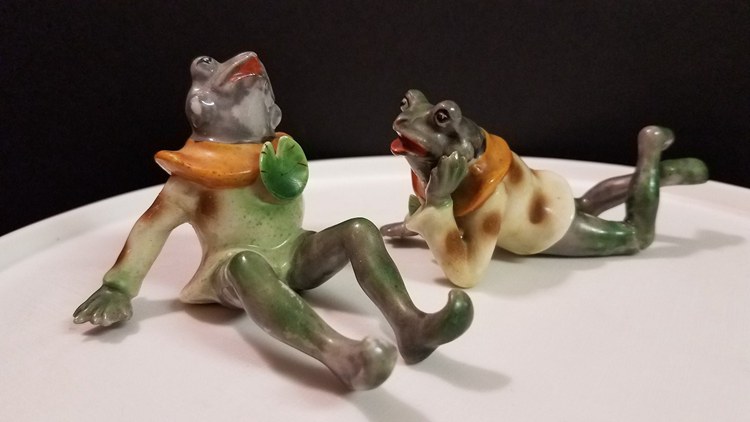
Unlike the typical squat, these twin frogs have human-like features in their sitting and lying positions. Their facial expressions are also animated, adding a quirky feel to their demeanor. Their colors are mostly green and yellow with a dash of other hues here and there.
1. Porcelain Moriyama (Dancing Woman)
Price: $150
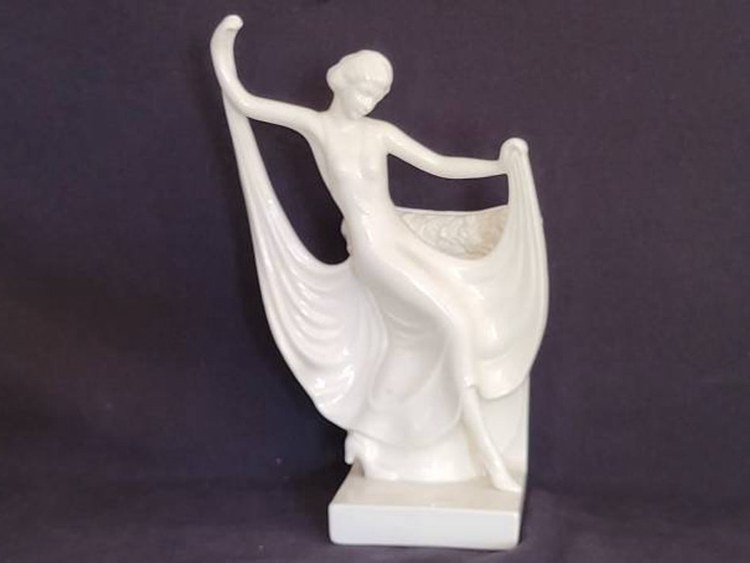
This Art Nouveau/Art Deco style white figurine depicts a dancing woman with a flowing skirt standing on a 90° roman pillar-style base. It’s a rare find and has the Moriyama logo printed beneath the base.
How to Identify Occupied Japan Figurines
Even though Made in Occupied Japan Figurines are affordable, some dubious people still make cheaper reproductions and copies. Whereas reproductions are exact replicas, Copies are stylistic imitations with slight changes.
Unfortunately, Made in Occupied Japan figurines don’t have a specific design or color palette you can leverage for identification. Since the statuettes are replicas themselves, the best thing you can do is rely on the naming underneath.
Identification by name
Check under or behind the figurine for the Made in Occupied Japan mark. You’ll see a trademark “T” in a circle. Made in Occupied Japan figurines made pre-1921 have Nippon labeled on them while post-1921 products have Japan.
Some manufacturers used company logos instead of the “Made in Occupied Japan” phrase. Watch this video to see the difference.
What is the value of Made in Occupied Japan Figurines?
Made in Occupied Japan figurines aren’t worth much because they’re copies of original American and European designs. Unlike original producers like Hummel, Meissen, and Royal Doulton, they often used cheap materials, hence their low retail value.
However, a few exceptions to the rule, like products that used good materials even though cheap, exist. Before we get into the various value appreciating factors, let’s talk about value types.
Value in antiquing and collectibles isn’t a one-way street – it’s a highway with many twists and turns. The buying cost isn’t the same as the selling price or insurance premium. So, what’s the difference, you may ask. We’ll tell you in the table below.
ValueMeaningWholesaleAs a dealer, the price you pay is about 33-50% less than retail.RetailThe selling price to collectorsFair MarketOtherwise known as Best Price, this price arrived in a bargain. The seller must give buyers full disclosure to decide on a commensurate value.InsuranceThe cost of replacing the Occupied in Japan Figurine in case of damage or theft.AuctionOtherwise known as the Open Market price is the starting bid after which the bidders determine the value. What are you willing to pay so that the other person doesn’t get this item?Tax/EstateThe average auction value uses similar or exact items as a focal point.
| Value | Meaning |
| Wholesale | As a dealer, the price you pay is about 33-50% less than retail. |
| Retail | The selling price to collectors |
| Fair Market | Otherwise known as Best Price, this price arrived in a bargain. The seller must give buyers full disclosure to decide on a commensurate value. |
| Insurance | The cost of replacing the Occupied in Japan Figurine in case of damage or theft. |
| Auction | Otherwise known as the Open Market price is the starting bid after which the bidders determine the value. What are you willing to pay so that the other person doesn’t get this item? |
| Tax/Estate | The average auction value uses similar or exact items as a focal point. |
NB: The Insurance Value is the highest monetary value attributed to an antique item. It’s often double the retail price.
Now, let’s discuss the factors contributing to Retail, Wholesale, Fair Market, and Auction value.
Certification
A Certificate of Authentication Template
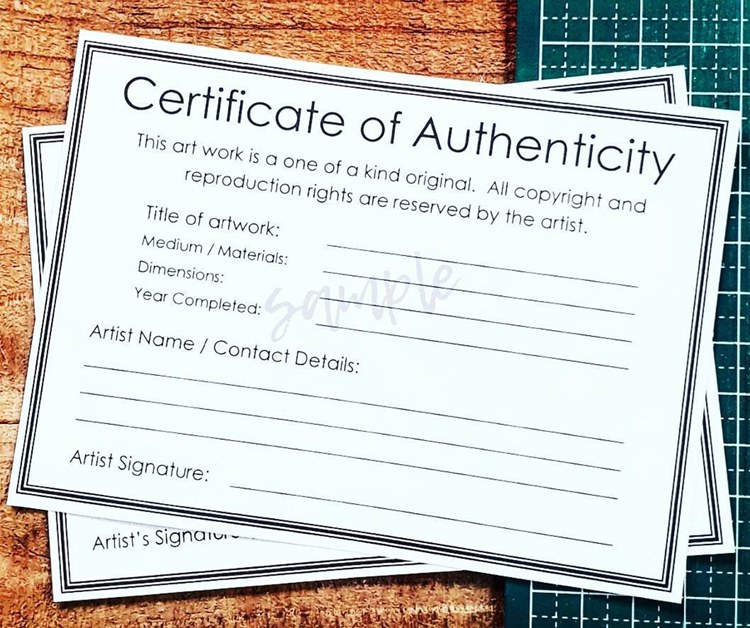
If you sell your Made in Occupied Japan figurine with a Certificate of Authentication (COA), the value appreciates because that hard copy is a guarantee of its legitimacy. You can consult an appraisal company to authenticate and evaluate your item if you wish to lend it credence.
It’s, however, not compulsory, as buyers don’t often request a COA. They’ll only ask for one if the price of your Made in Occupied Japan figurine seems too high or ridiculously low. On the flip side, as a buyer, know when to request a COA.
You can also hire an independent appraiser if you’re skeptical of the COA’s legitimacy. There are scammers everywhere who’ll do anything for some money, including forging a COA, so beware.
Characters
Figurines are often depictions of humans or animals made of porcelain, ceramic, gold, and other natural resources. Though Made in Occupied Japan figurines take inspiration from the Western world, some original pieces depict Japanese mythology.
Whichever character your statuette represents influences the bottom line because it speaks to sentiments, nostalgia, and history. For instance, a depiction of a known cartoon character would have higher demand due to its popularity, unlike an abstract model.
Classic Characters
Collectors connect personally with famous characters from Kid’s cartoons, storybooks, and mythology. It’s a great way to reignite and preserve fond childhood memories, and when you add an autograph to the mix, you’ve struck gold.
Sometimes, when artisans form a statuette after a known character like Disney’s Mickey Mouse or Cinderella, they get the original creators to sign autographs on them. That’ll drive the price higher than an unsigned design and travel miles ahead of an abstract model.
Multiple Characters
Because most Made in Occupied Japan figurines were handmade, creating multiple characters took extra effort and skill. Consequently, the cost for a multiple character figurine is significantly higher than that of a single character. You can revisit the list above for a better understanding.
Also, many Occupied Japan figurines came in pairs, so complete sets sell higher than singles. You should note, though, that it’s rare to find lost pairs making complete sets of high-valued items.
Full-Length Characters
Height is another definitive feature of Made in Occupied Japan figurines. Visualize this mentally – There are two similar figurines on a shelf; one is 3-inches tall while the other is 8-inches high. Which one would you rather choose?
Bold-sized figurines command higher values because they often have more prominent features and make for noticeable décor. Except you’re buying multiple miniatures, it’s unlikely you’ll get more than $5 apiece.
Historical Significance
You’ve seen the Yamabushi Tengu Kutani Ware Yōkai in the preceding list, so you somewhat understand the significance of immortalizing historical characters and events in figurines. Many Occupied Japan figurines take the form of Western characters reminiscent of the allied forces.
You can look at the Colonial Masters and American Lady figurines, and they’ll transport you back to a time when women wore ball gowns as casual outfits and men wore stockings. Thus, figurines that serve as memorabilia attract high premiums.
Condition
Would you buy a broken or damaged figurine? The reaction you had reading that question summarizes the importance of condition in evaluating your Made in Occupied Japan Figurine.
Because these statuettes aren’t of the highest quality material, they’re susceptible to wear and tear. Every chip, fade, crack, and craze depreciate its already modest value.
Through decades, the ability to preserve its state would add extra dollars to the bottom line. So, remember to maintain your Made in Occupied Japan figurines.
How much are Made in Occupied Japan Figurines?
“Made in Occupied Japan” products were affordable in their heyday, making them less valuable in today’s economy. Many of the items retail under $50, so if you’re looking to make a quick fortune, sorry to burst your bubble.
Professional collectors recommend selling in pairs to increase the value. Also, figurines in original packaging and stellar condition fetch higher values. You can browse online retail stores like eBay or consult prices like Kovels for current value.
Consult a qualified appraiser like WorthPoint for a token if you’re still unsure.
Parting Words
Gene Florence’s book Occupied Japan Collectibles holds all the information you need from pricing to identification. You can identify a copy in these three easy steps;
- There’s no “Occupied” before Japan
- The period mark (.)underglazes
- You can peel off or scratch the rubber stamp
We hope this article answers all your questions. There are a few more answers to frequently asked questions below. If you’re still curious, please leave a comment below, and we’ll reply to you as soon as possible.
FAQs
Q: Who Made “Made in Occupied Japan” Figurines?
A: By the end of WWII, Western Allied forces Occupied Japan until early 1952, hence the name. Losing the second World War negatively impacted the Japanese economy, so the citizens made pottery and crafts abroad. They labeled the products “Made in Occupied Japan” to track their movements across the globe. It also assured American consumers of Western supervision, soothing their initial reluctance to patronize the former axis nation.
Q: Why are Occupied Japan Figurines Collectible?
A: Although Made in Occupied Japan pieces weren’t high scale, there was a peaked interest in the 1960s. Western forces leaving the region took keepsakes back to their home countries, bringing attention to the modest reproductions.By the 1980s – 1990s, the collection of Made in Occupied Japan items skyrocketed, making some people form a group – The Occupied Japan Club – involved in all things Made in Occupied Japan. However, collectors’ interest lies solely in Made in Occupied Japan collectibles overlooking “Japan” or “Made in Japan” products from the same era.






![Vintage Schwinn Bikes: [Types, Identification, and Values]](https://www.txantiquemall.com/wp-content/uploads/2022/05/5.-Schwinn-1967-Ramshorn-Fastback-Stingray-Sky-Blue-vtg-600x450.jpg)
